Content
Lineage
This my understanding of the progression of product design concepts of which the Konix Multi-system was merely a part:
Sinclair Loki --> Flare One --> Slipstream (AKA Konix Arcade system) --> Konix Multi-system --> AVP (Flare's OEM version of the Konix Multi-system chipset)--> Atari Panther --> TXE Multi-system (designed by MSU - built for TXC) --> Atari Jaguar --> Nuon.
Below is a breakdown of the fullest possible information that I can provide relating to each of these evolutionary path twists and turns.
Sinclair Loki
It all started with the Loki - well, actually it's probably better to say that it all started with Sinclair. Martin Brennan, Ben Cheese and John Mathieson were all employees of Sinclair Research who (if you don't know) were a very successful company based in Cambridge, England. All graduates from Cambridge University and working for a brilliant and somewhat eccentric character - Sir Clive Sinclair, these young men no doubt had a burning desire to design the best machine they could (if money were no object).

Sinclair Research
At Sinclair, cost was very definitely a driving force, in an attempt to be able to produce working technology at a very affordable price for the consumer, in order to saturate the market at the expense of the competition, every corner was cut - every margin squeezed.
This was the era of pioneering home computer development when it was
finally starting to become a realistic prospect that everybody in the country
could own a 'home' computer.
Getting to that crucial affordable price point was the motivation. Whether
Loki was an internal Sinclair project that the whole company worked on, a
idea in one person's head or the results of a small R&D team's collective
dreaming, is almost irrelevant these days. It appears that the Loki never
made it past the drawing board.
In fact it probably never even made it that far, it's been said by Simon Goodwin that it was merely a shopping list - or a wish list for what it's imagineers believed would constitute a great computer. At the time, it was decided that this couldn't possibly be made for the expected cost and that it was a wasted effort.
I've never seen a prototype, I don't believe anyone has. What the Loki does do though is act as a catalyst. No doubt the boys wanted to develop something like this machine and found that they couldn't fulfil their ambitions at Sinclair, so they set up a company of their own just outside of Cambridge in a village called Cherry Hinton. Their company was called Flare Technology (N.B. Flare not Flair).
I've read that one of the first projects Flare worked on was the "RAM
Music Machine" for the Spectrum.
It apparently used some of the ideas from the audio aspect of the Loki
concept. This would have been used to raise money to allow them to develop
their 'Flare One' computer system.
Flare worked as consultants and designed other products and projects for a few manufacturers, but we're obviously interested in what led up to the Konix Multi-system and how we got there (and beyond)

Sir Clive in his C5
This is where they would take their plan for a low cost but very powerful computer capable of full colour (whereas the Spectrum had "novel", vaguely coloured graphics) with full MIDI capability built in, Floppy disk, a healthy amount of memory for the time, and a set of powerful custom chips that they would develop themselves that gave them the best of all worlds, a DSP (a custom co-processor which can do whatever additional processing you want - 3D computations, mathematical algorithm crunching, music or audio effects processing). A Blitter for producing the kind of graphics that they wanted in order to match or maybe even beat rival machines such as the Amiga 500.
This machine was called the Flare One - but more about that further down the page...
There are a few sketches floating around the internet purporting to be the Loki. Take them with a healthy amount of caution - treat them just like the consistently incorrect fantastical fan-made renders of the latest PlayStation or iPhone models that often float around that are almost never even remotely close to what the unit finally looks like.
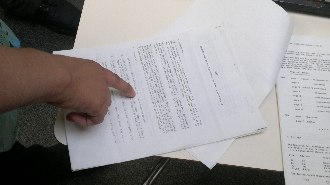
Loki technical documentation
The Loki was fleshed out at least into the technical ground work of what was being imagined, as statement of intent or a speculative definition if you will. This photograph of the Loki reference document (understood to be the property of Simon Goodwin) provided by Jon Pennycook taken when he attended a 30th anniversary talk about Sinclair at the Anglia Ruskin university in Cambridge shows that at least something existed.
The following text is a transcript of what's written on the front page and serves as a useful and unabashed indication of the intention behind the Loki to be a super computer of the time (at an affordable price), a design ethos that persisted through to the Konix Multi-system.
Compare what's written here with the other Flare reference documents in this website - it's suspiciously similar language in the Flare products. It's my belief that one of the Flare Team, possibly John wrote this document and that they carried on with this mission when they produced their Flare One computer - so to that end, I think it's not crazy to suggest the Flare One IS for all intents and purposes a realised version of the Loki.
LOKI
Specification of the Super-Spectrum Entertainment Engine
1 DESCRIPTION
LOKI is intended to be a replacement to the Spectrum 128K, selling for less than 200 pounds. The innovative features (at this price) will enable it to be sold to a wider consumer market than the computer games/hobbyist market, as well as enticing existing computer owners to upgrade.
The sound facilities will have the capabilities of a commercial synthesiser; and these facilities, combined with front-end software, should allow the machine to be sold to the home music market. This facility includes a MIDI interface.
The graphics facilities will allow better animation effects than any existing home computer, and will allow cartoon quality graphics. Facilities included in the base machine will later support the addition of CD or Laservision to upgrade these effects. There is a facility to allow the machine to be locked to an external video source. This will allow the machine to be used as a tool for home video use (captions etc.) and several machines to be locked together.
1.1 Features
1. Z80 main processor running at 7 Mhz (twice Spectrum speed).
2. 128K of RAM, composed of 2 64Kx4 dual port video RAMs and 2 64Kx4 ordinary dynamic RAMs. It is possible to expand the machine to have 1 Mbyte of address space.
3. Display resolutions of 256x212 with 8 bits per pixel, or 512x212 with 4 bits per pixel.
4. Spectrum 48/128 software compatibility mode (128 sound may be a problem).
5. Rasterop hardware performing screen animation, scrolling and line draw.
6. Polyphonic synthesiser quality sound.
So, there you have it - at the essence of all of this lineage is a "Super Spectrum Entertainment Engine". Not dissimilar to the idea by Miles Gordon Technology with their SAM Coupé computer, which did get released, although didn't exactly set the world alight and failed to spawn any further iterations.

Crazy Loki concept image
Chris Owen's Website has its own take on the Loki, although despite doubts surrounding their ambitions at the time, time later proved that it wasn't actually that hard for Flare to produce the machine that they promised. The problem laid more with who they could find to put the money behind the commercial development of it; Who was going to manufacture and promote it?
With thanks to user Rorthron of the World of Spectrum forum who has posted a link to a Register article regarding Sinclair's other projects, there is some more information that I wasn't aware of that we can now share, it throws the project into a state of something being a little more developed a concept than otherwise indicated elsewhere - but I believe it was still quite far away from getting from a breadboard prototype to printed circuit board.
Atari Panther
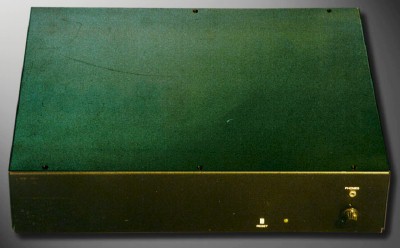
Atari Panther prototype
As discussed in my interview with Martin Brennan, the Panther was an existing internal project that Atari was working on. Martin was bought in by Richard Miller, a former colleague at Sinclair, to help finish off the design. It is not a direct forefather of the Flare One or Konix Slipstream system, more a cousin.
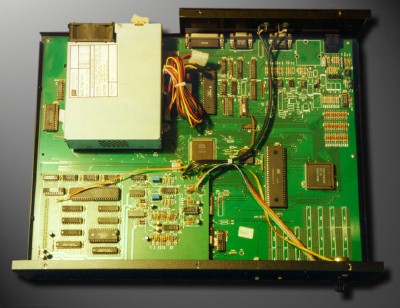
Atari Panther Internals
There are various internet Forums and Websites with information regarding the Panther. It is a close relation to the Jaguar in as much as the same people were to some extent involved in it. And although based on different hardware, two games that found their way onto the Jaguar were initially written for the Panther and later ported when the project was canned (although these games would have taken a lot of re-writing in order to port them from one system to the other because of the differences in hardware).
Passport Low Cost Computer
Prior to the Flare One, Flare had designed a personal computer. The Passport LCC gave us the CPM Operating system that was still used in the Flare One. We have a disc with that OS on it and it's emulated in the Slipstream emulator.
What follows is a description of the Passport LLC. I don't believe an actual computer made it past the prototyping stage, possibly not even into any physical form. I certainly haven't (so far) been able to find anyone who might have encountered one. I also don't think it was picked up by any manufacturers and re-badged in their name.
FAX
TO: SUNIL RODRIGUES, IDS
FROM: JOHN MATHIESON, FLARE TECHNOLOGY
RE: PASSPORT COMPUTER PROJECT
Date: 21 July, 1988
1. Features
The current features of the machine are as follows, and closely correspond to the original list of features:
Base Unit
- Screen modes:
- 256x192 in 16 colours giving 32x24 characters
- 256x256 in 16 colours giving 40x25 characters
- 512x256 in 2 (selectable) colours giving 80x25 characters
- Memory:
- 64K RAM
- 16K ROM
- Input/output:
- 40key matrix keyboard
- IBM PC compatible keyboard interface
- Joystick interface
- Cassette recorder interface
- RGB or monochrome or composite PAL monitor interface
- UHF TV interface giving colour picture with sound
- Expansion unit interface
- DC power input
- Software:
- BBC Basic interpreter
- Compatible software loader
Expansion unit:
- Floppy disk interface
- Serial/parallel ports
- Additional ROM
- NiCd power backup
- DOS providing CP/M application interface, using IBM MSDOS compatible disk format.
2. Timescales
The base unit design is now complete and a PCB layout has been generated. The gate array design has been completed and simulated, and is currently being laid out. Gate array signoff with Qudos will occur by the end of next week (30th July), and gate array samples should be ready 46 weeks from that date, at which point we will be able to deliver prototype units to you, this should be in early September.
The expansion unit design has not been done yet, but should prove straightforward, and should be ready when the base unit prototypes are available.
The Basic interpreter is currently in an advanced state of development, and should be complete when the base unit prototypes are ready, as should the DOS for the expansion unit.
3. Memory
The confusion regarding the memory is: the design is based on two 64Kx4 devices (4464s) which use 256Kbit dRAM technology. We understand that the current shortage of devices based on 256Kbit technology will continue well into next year, whereas the 1Mbit technology device shortage will ease this year. It is possible to redesign the gate array to use 1 256Kx4 device (this is based on 1 Mbit technology), but this decision has to be made now. Ben therefore enquired whether your supply of 64Kx4 devices was assured, or whether you would like us to change the design. We are continuing the design based on the 64Kx4 devices.
4. Power consumption
We expect the base unit to require 200-300 mA from a 9V nominal external DC power supply, however, the IBM PC keyboard requires an additional 200mA, bringing the total power supply requirement to 500mA.
Flare One
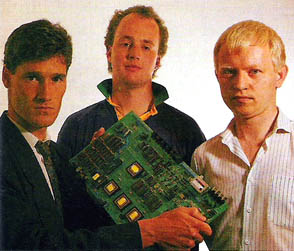
The Flare Team with the Flare One PCB
And so we come to the Wunderkind - this is the really impressive part of all this. It was very powerful, cheap, offered you the capability to do whatever you wanted to do with it and could well have set the world on fire.
I remember getting very excited about this machine when I read about it in ACE Magazine. Although I wasn't able to see moving demos and there were no games announced or being developed (It was really nothing more than a prototype system); still, due to ACE's coverage it created a great excitement and sense of anticipation.
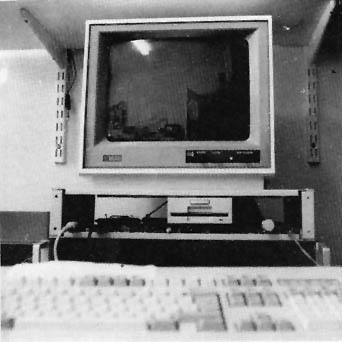
Full Flare One prototype system setup
However, it didn't get picked up by existing hardware manufacturers with the money to develop it into something great, it didn't have the chance to prove itself other than in tech demos promising tremendous power for the cost. This was a shame, but then the SAM Coupé didn't set the world alight either despite being a similarly powerful computer. The SAM shares no common technology with the Flare products.
The Flare One could have had an almost instant development base of thousands of programmers due to the fact it used a Z80 CPU which means that they would all have been very familiar with writing Z80 assembly language.
There are several scans in the Press section of this website from ACE Magazine which chronicles the development from Flare One to Konix Multi-system. They go into great depth and are a fascinating read. I recommend checking them out. Ace really made a feature out of the system I'm sure they knew it had great potential.
Slipstream
When Konix became involved, the Flare One was further developed and become the "Slipstream", it took on the same name as the prototype for the reconfigurable joystick that Konix designed to become the custom chip for the Flare One based system.
AVP
Although the time line isn't precisely clear, the Flare AVP system (Flare's name for the Flare One in it's custom system form as it was to be pitched to prospective OEM manufacturers) was being sold independently of the Slipstream as an all in one system on a chip to be used by anyone wanting a powerful/useful computer system with minimal exotic supporting components.
Bellfruit efficiently used the Flare One prototype technology as it was four chips with separate FDD driver and a Z80. It's not entirely clear if the AVP was only ever sold in the four chip configuration or the one chip "Slipstream" configuration.
Flare always owned the design, they licensed it to Konix (getting potentially one pound for each machine built - it's in the bill of materials price list), and despite further developing the Slipstream to Konix's specifications, the Slipstream chip was still a Flare product. No doubt just going by the name AVP (probably Audio Video Processor) when being sold to prospective clients.
Konix Arcade System
The early name for the Multi-system, when it was still closer to a Flare One, with a Zilog Z80 CPU, this is what some of the Z80 based demos were calling the machine. I prefer this name, but no doubt Konix fell into the common manufacturer's trap of thinking that a pure games system wasn't attractive to Kids (or, more likely, probably parents as they'd be the ones with the money to buy it for the Kids). It's a common mistake that is STILL being forced on us by clueless managers in games hardware companies - convergence seems to be the aim, banality is often what they achieve.
Konix Multi-system
Well, of course, this whole website is regarding the Multi-system so there's not much point going on at great length about it here - suffice to say that it fits very neatly in this position - after the Flare One, and before the Jaguar / MSU Multi-system.
TXE Multi-system (designed by MSU - built for TXC)
A flawed machine, although it's graphics resolution was improved, memory
increased and CDROM storage was added to be capable at least of running
PC/Amiga ports with relative comfort (such as Robocod 2). The latter
Slipstream chipset version in this system was reportedly very buggy.
It was underpowered in the face of the competition. No matter what processor
was thrown at it, the core graphics technology should have been boosted with
better 3D capabilities, and the whole bus contention design should have been
addressed. There is a LOT more detail about this in the MSU section of the
website.
How to avoid getting confused by these names:
1) TXC is the manufacturer who paid MSU to build a CD player with game playing capabilities using the Slipstream chip.
2) TXE is the name of this CD Player Game system
Atari Jaguar
Flare went on to produce the Flare Two which was sold to and further developed (finished off) by Atari (including Richard Miller - remember him from earlier?). This was the proving ground for the evolution of the Flare One / Slipstream / AVP design - minus the Konix controls.
The Flare Two became the Atari Jaguar.
By this time, and for whatever reason, Atari had decided on ROM Cartridge
as the media to be used for storing and distributing games - a latter CDROM
unit add-on came too late.
The most probable reason is (historically) an
attempt to thwart piracy and therefore protect profits. This is the strategy
Nintendo and other adopted. It stops casual copying by people with no
electronics skills, but it doesn't stop those people buying blank cartridges
from someone with the skills to design and manufacture them.
Reportedly pretty difficult to program, and supporting quite a nasty bug that
was only learnt about later in its life (once consoles were in the hands of
customers - before the days of System updates where problems can be fixed by
manufacturers later) that reduced its capabilities somewhat, the Jaguar was
released and had a fair chance to show off its capabilities.
The Jaguar gave life to the still current Rayman series of games, it was capable
of reasonable 3D, it could have taken on the Sony PlayStation 1 but for the
lack of CDROM. And support from more developers.
By this time, Atari had long since lost it's ability to make successful
consoles - the glory of the Atari ST home computer was that it could do it
all, it was a great games machine, a good solid home computer, and a great
Music enthusiast's machine because of it's built in MIDI interface. The
Jaguar with its (arguable) 64 bit moniker and inflammatory "Do the Math"
advertising campaign unfortunately failed to set the world alight. The Atari
Jaguar was rushed out at the end of the companies life, and it showed.
It makes you wonder, with the difference in drive and business mentality
behind Konix and Atari if the Multi-system was released, how well
would it have done?
Personally, I think it would have done quite well. It was capable, it had
some good games being developed, it was novel and exciting, and with Jon Dean
managing the software releases it was going to have been off to a good start
from day one.
Despite the benefit of hindsight telling us that the Jaguar was not as successful as it's rival the PlayStation and the Nintendo N64, let's not forget that this machine really pushed the envelope in terms of design - they didn't use off the shelf graphics chips and the like - these guys designed the machine from the bottom up to be the best performing system that existed at the time.
This was a strategy they used right from the start - the Flare One that became the Multi-system was designed in the same way, to maximize everything they could to allow for performance to be the best for the money. The Jaguar was a good machine; ignore the 32/64 bit argument and the lack of great games.
What I find quite telling is that one of the Flare Two/ Atari Jaguars creators Martin Brennan was very surprisingly unaware of what the finished Jaguar looked like. It appears that he took only an interest in the initial development of the system and was not involved with the consumerisation of the machine and seemingly took little interest in it's commercial release. I'm not going to say he took the pay check and ran, but I would have assumed he'd be involved from cradle to grave.
Although a later CDROM add-on came out and a prototype combination machine was dreamt up, it should have been there from the start. The NEC PC Engine enjoyed a CDROM add-on which provided many great games much earlier, other CDROM add-ons for popular machines such as the Megadrive / Genesis didn't fare quite so well. Of the supposed 40 million Megadrive / Genesis consoles sold, only 6 million CD unit add-ons were sold (figures from Wikipedia).
Nuon
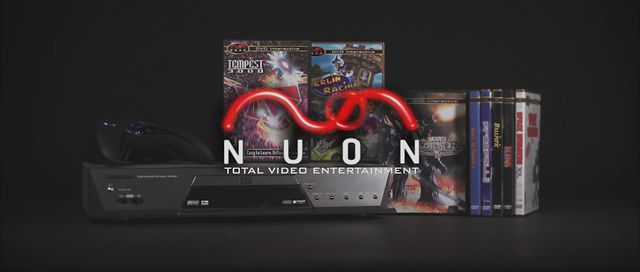
Link to Fan-made Nuon overview video
VM Labs's Nuon is a project that re-united John Mathieson, Richard Miller (again) and Jeff Minter - how can I not mention it here? Again - not a direct descendant, more a cousin (or an evolution?), the spirit probably somewhat tenuously lived on in the Nuon.
It was again being developed as a chipset for OEM manufacturers to employ in their systems, this time to be used in DVD players so that any Nuon enhanced DVD player could play reasonable 3D games.
Not a powerful enough brand on it's own to encourage people to buy a DVD player to just play games, it inevitably failed to set the world alight.
It's not a bad business model, but in the field of video games, it's never really worked. VM Labs did a good job of selling it to a few manufacturers such as Toshiba and Samsung - unfortunately it wasn't wide-spread enough for it to be in every house and therefore the de-facto standard.
It's maybe worth ruminating on why the Flare guys had this OEM attitude. Did they learn it in University or through their time at Sinclar? It may have been interesting to see what they may have developed if they had worked for a different company, a large Japanese firm such as Nintendo, or perhaps an American Giant like IBM or Commodore. Of course there are pressures to maximise profit in all companies, but they didn't seem to want to latch them selves to one company and develop closed systems, they wanted to create what could be used repeatedly.
Visit the Nuon-dome website for all the Nuon information you could ever want.
